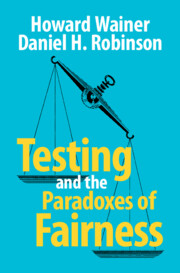Book contents
- Testing and the Paradoxes of Fairness
- Reviews
- Testing and the Paradoxes of Fairness
- Copyright page
- Dedication
- Annotated Table of Contents
- Preface
- Acknowledgments
- Chapter 1 A Brief Recounting of the First Four Millennia of Testing
- Chapter 2 Why Tests Are so Widely Disliked
- Chapter 3 The Origins and Consequences of Mental Testing in the U.S. Military
- Chapter 4 Testing in Grades K-12
- Chapter 5 Licensing Examinations
- Chapter 6 Admission Testing for Higher Education
- Chapter 7 Tests Used for Merit-Based Scholarships
- Chapter 8 Using Student Test Scores to Evaluate Teachers: An Assessment of Value-Added Models
- Chapter 9 Dividing Test Scores into Subcomponents
- Chapter 10 On Cost Functions in Testing
- Chapter 11 Evidence in Science: Should We Use Data and What Data Can We Trust?
- Chapter 12 Three Cautionary Tales of Zombie Ideas about Testing
- Chapter 13 Coda
- References
- Index
Chapter 6 - Admission Testing for Higher Education
Published online by Cambridge University Press: 10 October 2025
- Testing and the Paradoxes of Fairness
- Reviews
- Testing and the Paradoxes of Fairness
- Copyright page
- Dedication
- Annotated Table of Contents
- Preface
- Acknowledgments
- Chapter 1 A Brief Recounting of the First Four Millennia of Testing
- Chapter 2 Why Tests Are so Widely Disliked
- Chapter 3 The Origins and Consequences of Mental Testing in the U.S. Military
- Chapter 4 Testing in Grades K-12
- Chapter 5 Licensing Examinations
- Chapter 6 Admission Testing for Higher Education
- Chapter 7 Tests Used for Merit-Based Scholarships
- Chapter 8 Using Student Test Scores to Evaluate Teachers: An Assessment of Value-Added Models
- Chapter 9 Dividing Test Scores into Subcomponents
- Chapter 10 On Cost Functions in Testing
- Chapter 11 Evidence in Science: Should We Use Data and What Data Can We Trust?
- Chapter 12 Three Cautionary Tales of Zombie Ideas about Testing
- Chapter 13 Coda
- References
- Index
Summary
Many colleges that required SAT or ACT scores before the pandemic suspended them during it. After the dangers of the pandemic subsided most have not yet resumed their use. The arguments supporting their continued suspension are based primarily on the fact that such tests, like most other tests, show differences among subgroups (e.g., races). We discuss the costs and benefits of no longer using such tests scores in admission decisions. College admission tests were developed in the 1920s to level the playing field and allow more students to qualify for college. Carl Brigham developed the Scholastic Aptitude Test (SAT) in 1926. Soon, the College Board adopted the SAT. In 1959, the American College Test (ACT) was born. Neither test is biased against minorities – rather they tend to overpredict minority performance in college. Yet, despite persistent group differences, the sentiment is to discontinue use of these tests. Doing so will place more emphasis on other metrics (e.g., high school GPA) that are less reliable, more subjective, and also prone to group differences. Admitting more students who are less likely to graduate comes with costs.
Information
- Type
- Chapter
- Information
- Testing and the Paradoxes of Fairness , pp. 72 - 81Publisher: Cambridge University PressPrint publication year: 2025
Accessibility standard: Inaccessible, or known limited accessibility
Why this information is here
This section outlines the accessibility features of this content - including support for screen readers, full keyboard navigation and high-contrast display options. This may not be relevant for you.Accessibility Information
Content Navigation
Allows you to navigate directly to chapters, sections, or non‐text items through a linked table of contents, reducing the need for extensive scrolling.
Provides an interactive index, letting you go straight to where a term or subject appears in the text without manual searching.
Reading Order & Textual Equivalents
You will encounter all content (including footnotes, captions, etc.) in a clear, sequential flow, making it easier to follow with assistive tools like screen readers.
You get concise descriptions (for images, charts, or media clips), ensuring you do not miss crucial information when visual or audio elements are not accessible.
You get more than just short alt text: you have comprehensive text equivalents, transcripts, captions, or audio descriptions for substantial non‐text content, which is especially helpful for complex visuals or multimedia.
Visual Accessibility
You will still understand key ideas or prompts without relying solely on colour, which is especially helpful if you have colour vision deficiencies.
You benefit from high‐contrast text, which improves legibility if you have low vision or if you are reading in less‐than‐ideal lighting conditions.
